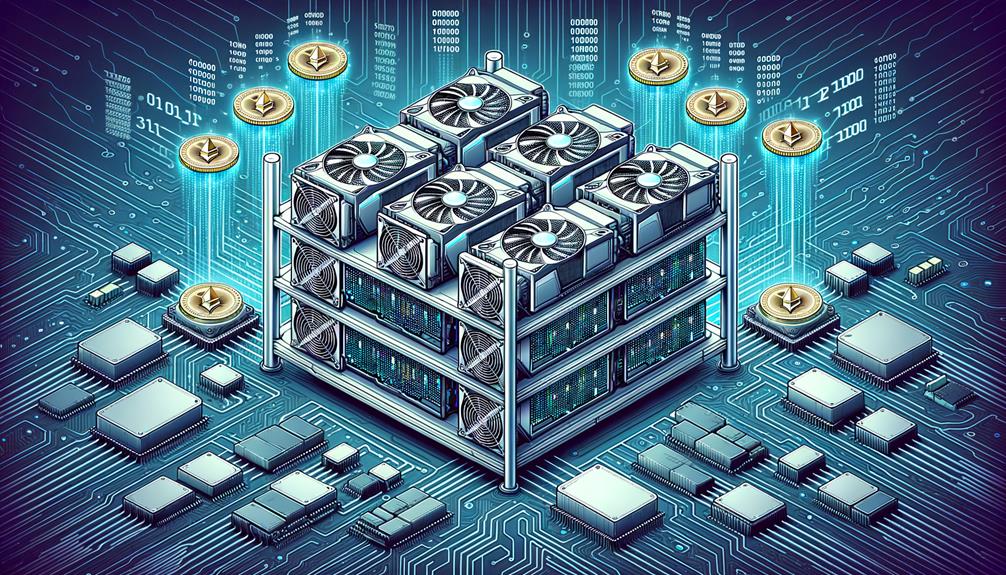ethereum bitcoin mining A Comprehensive Overview
Ethereum bitcoin mining has become a buzzword in the world of cryptocurrencies, drawing attention from tech enthusiasts and investors alike. As both Ethereum and Bitcoin continue to evolve, understanding their mining processes and the implications they hold for the future of digital currency is essential.
This guide delves into the nuances of mining both cryptocurrencies, exploring their differences, hardware requirements, profitability, environmental impact, and future trends. Whether you’re a seasoned miner or just starting, this overview aims to equip you with the knowledge you need to navigate the complex landscape of cryptocurrency mining.
Overview of Ethereum and Bitcoin Mining

Mining cryptocurrencies like Ethereum and Bitcoin plays a crucial role in securing their networks and validating transactions. While both processes share some similarities, there are distinct differences that set them apart. Bitcoin mining primarily involves solving complex mathematical problems through a process called proof of work, which consumes significant computational power. Ethereum, on the other hand, has transitioned to a different model known as proof of stake, although it still has a proof of work mechanism in place for its earlier versions.
Bitcoin mining is heavily reliant on specialized hardware known as ASICs (Application-Specific Integrated Circuits), which are designed solely for this purpose. In contrast, Ethereum mining can be performed using both GPUs (Graphics Processing Units) and ASICs, though the latter is becoming more popular as the network evolves. When it comes to energy consumption, Bitcoin mining is notably more intensive than Ethereum mining.
According to recent statistics, Bitcoin mining consumes approximately 89 TWh annually, while Ethereum’s energy consumption is around 44 TWh. This disparity highlights the environmental concerns associated with Bitcoin mining and the ongoing discussions about sustainable practices in the cryptocurrency space.
Mining Hardware and Software
Setting up a mining operation for either Bitcoin or Ethereum requires specific hardware and software. The choice of hardware will significantly influence mining performance and profitability.
- For Bitcoin mining, recommended hardware includes:
- Antminer S19 Pro
- MicroBT Whatsminer M30S
- Canaan AvalonMiner 1246
- For Ethereum mining, suitable hardware options are:
- NVIDIA GeForce RTX 3070
- AMD Radeon RX 6800 XT
- ASIC miners like the Innosilicon A11 Pro
Additionally, there are several mining software options available for both cryptocurrencies. Popular choices for Bitcoin include:
- CGMiner
- BFGMiner
- EasyMiner
For Ethereum, some effective mining software includes:
- Ethminer
- PhoenixMiner
- Claymore
Setting up a mining rig involves assembling the necessary hardware components, installing mining software, and ensuring a stable internet connection. Key requirements include having sufficient cooling systems and a reliable power supply to handle the energy demands of the mining process.
Mining Pools and Solo Mining
Mining pools are groups of miners who combine their computational power to increase their chances of earning rewards. Joining a mining pool for Bitcoin or Ethereum offers several benefits, such as:
- More consistent payouts
- Reduced variance in earnings
- Access to shared resources and knowledge
However, there are also drawbacks, including:
- Pool fees can eat into profits
- Dependence on the pool’s performance and reliability
Solo mining is another approach wherein miners operate independently, but this method has its own challenges. The process requires significant computational power and can lead to long waiting times for rewards. For many, solo mining is no longer viable due to the increased difficulty levels in both networks.Popular mining pools for Bitcoin include:
- Slush Pool
- F2Pool
- Antpool
For Ethereum, notable mining pools are:
- Ethermine
- SparkPool
- F2Pool
Profitability and Economic Factors
The profitability of mining Ethereum and Bitcoin is influenced by various factors, including current market prices, mining difficulty, and transaction fees. The mining rewards for Bitcoin currently stand at 6.25 BTC per block, while Ethereum rewards vary depending on network conditions but average around 2 ETH per block.To provide a clearer picture, here’s a comparison of the current mining rewards, fees, and market prices:
| Cryptocurrency | Mining Reward | Average Transaction Fee | Market Price |
|---|---|---|---|
| Bitcoin | 6.25 BTC | $2.40 | $30,000 |
| Ethereum | 2 ETH | $5.00 | $2,000 |
Miners also face potential risks and challenges such as market volatility, regulatory changes, and the continual threat of technological advances that could render current mining hardware obsolete.
Environmental Impact of Mining
The environmental impact of cryptocurrency mining, especially Bitcoin, has raised significant concerns. Bitcoin mining consumes an immense amount of energy, much of which comes from non-renewable sources, leading to higher carbon emissions. The carbon footprint of Bitcoin mining is an ongoing debate in environmental circles.In contrast, Ethereum’s move towards a proof of stake mechanism, which significantly reduces energy consumption, presents a more sustainable approach to mining.
The shift is expected to decrease Ethereum’s energy use by over 99%, paving the way for a greener future in the cryptocurrency ecosystem.Examples of sustainable practices in mining include:
- Utilizing renewable energy sources like solar or wind.
- Implementing energy-efficient mining hardware and cooling solutions.
- Participating in carbon offset programs.
Future Trends in Mining

The future of mining for both Ethereum and Bitcoin is set to evolve dramatically in the coming years. As technological advancements continue to emerge, mining efficiency is likely to improve, reducing costs and environmental impact. Innovations such as AI-driven mining software and more advanced ASICs could increase output and energy efficiency.Moreover, regulatory changes are anticipated to impact mining operations significantly.
As governments around the world consider regulations for cryptocurrency mining, compliance will become crucial for miners to avoid penalties and ensure the longevity of their operations. Potential trends to watch include increased adoption of proof of stake mechanisms, advancements in cooling technologies, and the potential for mining operations to integrate with renewable energy solutions.
Ultimate Conclusion

In conclusion, ethereum bitcoin mining presents both opportunities and challenges in an ever-changing digital landscape. By staying informed about mining practices, profitability, and environmental impacts, miners can make educated decisions that align with their goals and values. As we look to the future, the evolution of mining technology and regulations will continue to shape the cryptocurrency mining experience.
Question Bank
What is the main difference between Ethereum and Bitcoin mining?
The main difference lies in their consensus mechanisms; Bitcoin uses proof of work while Ethereum has transitioned to proof of stake, affecting energy consumption and mining processes.
What hardware do I need to mine Bitcoin and Ethereum?
For Bitcoin, ASIC miners are recommended, while GPUs are typically used for Ethereum mining. The specific hardware choices depend on your budget and mining goals.
Are mining pools worth joining?
Yes, mining pools can provide more consistent payouts and reduce the variance in earnings, making them a popular choice for many miners.
What are the environmental concerns related to mining?
Mining, particularly Bitcoin, consumes significant energy and contributes to carbon emissions. Ethereum’s shift to proof of stake aims to mitigate these concerns.
How do market prices affect mining profitability?
Market prices directly influence mining profitability; a higher coin value typically increases potential earnings, while lower prices can lead to losses after costs are accounted for.
